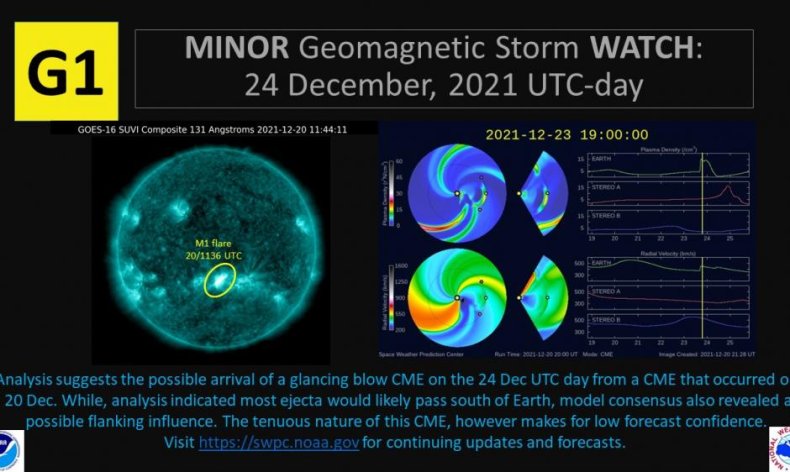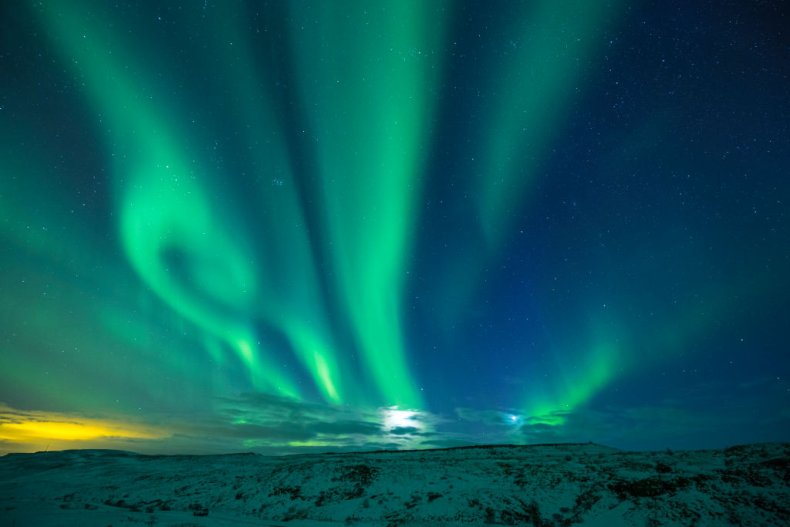A solar storm launched by the sun on Monday could impact Earth on Thursday and Friday causing increased activity in the northern lights over the North Pole.
The Met Office space weather forecasting center in the United Kingdom said the aurora over the Northern Hemisphere at high attitudes could be enhanced on December 23 going into Christmas Eve.
The European Space Agency (ESA) Space Weather Twitter account told followers that the sun had been "busy" with active regions across its surface keeping monitoring networks on their toes over the holiday season.
The Sun has been busy lately with active regions keeping us on our toes before the Holidays!🧐🎄The ESA #SpaceWeather Networks A-Effort solar flare forecasts predicts high probabilities of significant flares over the next 24hr✨👀
— ESA Space Weather (@esaspaceweather) December 21, 2021
🌐https://t.co/wlcWTSS4QQ#SpaceSafetypic.twitter.com/svAKCeWThW
The increase in solar activity is the result of nine sunspot groups across the sun's surface. Solar flares arise from these regions and release streams of charged particles into space which are known as Coronal Mass Ejections (CMEs).
These CMEs can take anywhere from between 15 and 18 hours to days to strike Earth depending on how quickly they are traveling when they leave the sun.
When these charged particles hit the magnetosphere of Earth they travel towards its magnetic poles. This is why the auroras of Earth, the aurora borealis, and aurora australis, also known as the northern and southern lights, are most visible at the North and South poles.
"These particles then slam into atoms and molecules in the Earth's atmosphere and essentially heat them up," Royal Observatory astronomer Tom Kerss said. "We call this physical process 'excitation,' but it's very much like heating a gas and making it glow."
This results in a very efficient exchange of energy from the solar wind into the space environment surrounding Earth and can produce major changes in the currents, plasmas, and fields in Earth's magnetosphere known as a geomagnetic storm.
An M-class—medium-sized—solar flare that occurred at 6:36 a.m. ET on December 20 has a CME associated with it which the National Oceanic and Atmospheric Administration's (NOAA) Space Weather Prediction Center says will strike Earth between late December 23 to early December 24.

NOAA predicts that the geomagnetic storm that arises as a result of the CME is predicted to be a minor one, striking a glancing blow to Earth's magnetosphere with most of the charged particles passing south of our planet.
Geomagnetic storms have the potential to disrupt communication, power, and electrical systems here on Earth. This is unlikely with a storm of this size, with the most extreme effect likely being beautiful light displays over the poles.
EarthSky says that it isn't yet clear if the increased auroral display caused by this CME will be visible over the continental U.S.


Post a Comment